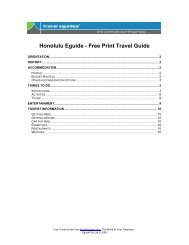Australia Eguide - Travel Guides
Australia Eguide - Travel Guides
Australia Eguide - Travel Guides
You also want an ePaper? Increase the reach of your titles
YUMPU automatically turns print PDFs into web optimized ePapers that Google loves.
107<br />
History<br />
Aboriginals first came to the place they called "cavvanbah" which means “meeting<br />
place”. Captain Cook noticed Cape Byron as he passed by in 1770, and it was he who<br />
named the location. However, it was not settled by Europeans until nearly a century later.<br />
The area where the town now stands was originally a swamp, a little of which remains on<br />
the eastern side. The village of Cavvanbah was surveyed in 1884 and the jetty built in<br />
1886. The railway came in 1894 and the name then changed from Cavvanbah to Byron<br />
Bay.<br />
The early growth was dairy and a number of separating stations were established. A cooperative<br />
was formed in 1895 to provide cold storage for perishable goods from the<br />
district, to manufacture, store, sell and export milk and dairy products. The factory over<br />
the years expanded to become the biggest butter factory in the southern hemisphere.<br />
A jetty was built at the end of the nineteenth century and a steamer service provided to<br />
Sydney. Then Byron Bay became a whaling town and a whaling station was built at<br />
Belongil Beach. In 1921, the S.S. Wollongbar, a passenger liner which could<br />
accommodate 300 passengers, was wrecked here just off Belongil Beach. It remains<br />
buried in the sands, causing a surf break by its presence, but all that can be seen are the<br />
boilers, visible at low tide.<br />
In 1973 hippies discovered Byron Bay and still come to Byron Bay. In recent years the<br />
developers have moved in and major developments have been taking place in what was<br />
once a quiet seaside village and now a significant coastal resort.<br />
Attractions<br />
Cape Byron<br />
Cape Byron is the easternmost point on mainland <strong>Australia</strong> and it has a strong influence<br />
on marine currents and marine life in the park. Humpback whales travel close to shore<br />
around Cape Byron on their annual migrations. The park is also renowned for its<br />
dolphins, seabirds, turtles and corals. Several coastal nature reserves, Arakwal National<br />
Park and Cape Byron State Conservation Area adjoin the marine park.<br />
Cape Byron Lighthouse<br />
The Cape Byron Lighthouse has stood on the most easterly point of the <strong>Australia</strong>n<br />
mainland for a century, and today you can take a tour of the tower. The rugged headland,<br />
surrounded by sheltered rainforest gullies and subtropical waters, is a great spot for<br />
watching turtles, dolphins and humpback whales on their annual migration.<br />
There are many ways to see the lighthouse and one of them is a leisurely walk. To walk<br />
to the Lighthouse it is possible to start from the car park outside the Beach Hotel, at the<br />
end of Jonson Street in the heart of Byron Bay. The walk covers about eight kilometres<br />
and takes 2½ hours.<br />
Free from <strong>Travel</strong><strong>Eguide</strong>s.com Online <strong>Travel</strong> Information.<br />
©2008 <strong>Eguide</strong> Pty Ltd




